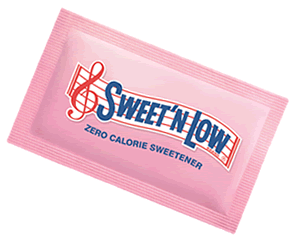

Managing Weight

Being overweight or obese poses a serious health risk to millions of Americans and increases the risk for a number of diseases and detrimental health conditions, including: heart disease, high blood pressure, diabetes, and certain cancers. Using Sweet'N Low can help individuals cut excess calories from added sugars and set the foundation for a safe and effective weight management program.
Defining Overweight & Obesity:
Overweight/obese status is determined by calculating an individual's body mass index (BMI) - a number that reflects the relationship of weight to height and serves as a good estimate of body fat. A healthy BMI ranges between 18.5 and 24.9. For example, a person who is 5'6” and 135 pounds has a BMI of approximately 21. A BMI between 25 and 29.9 is considered overweight, 30 and over is obese.
To calculate your BMI click here.

Key Facts About Overweight and Obesity
According to the National Heart Lung and Blood Institute nearly 70 percent of adult Americans are either overweight or obese. Overweight and obesity are major contributors to chronic disease in the United States. Research has shown that as weight increases to reach the levels referred to as "overweight" and "obesity," the risks for the following conditions also increases:
- Coronary heart disease
- Type 2 diabetes
- Cancers (endometrial, breast, and colon)
- Hypertension (high blood pressure)
- Dyslipidemia (for example, high total cholesterol or high levels of triglycerides)
- Stroke
- Liver and Gallbladder disease
- Sleep apnea and respiratory problems
- Osteoarthritis (a degeneration of cartilage and its underlying bone within a joint)
- Gynecological problems (abnormal menses, infertility)
Source: National Heart and Lung and Blood Institute

Patient Education
Useful Links
Physical Activity Guidelines for Americans
Low Calorie Sweeteners and Appetite
Key guidelines by group:
- Children and Adolescents (6-17 years of age): One hour or more of moderate or vigorous aerobic physical activity a day, including vigorous intensity physical activity at least three days a week. Examples of moderate intensity aerobic activities include hiking, skateboarding, bicycle riding and brisk walking. Vigorous intensity aerobic activities include bicycle riding, jumping rope, running and sports such as soccer, basketball and ice or field hockey. Children and adolescents should incorporate muscle-strengthening activities, such as rope climbing, sit-ups, and tug-of war, three days a week. Bone-strengthening activities, such as jumping rope, running and skipping, are recommended three days a week.
- Adults: Adults gain substantial health benefits from two and one half hours a week of moderate intensity aerobic physical activity, or one hour and 15 minutes of vigorous physical activity. Walking briskly, water aerobics, ballroom dancing and general gardening are examples of moderate intensity aerobic activities. Vigorous intensity aerobic activities include race walking, jogging or running, swimming laps, jumping rope and hiking uphill or with a heavy backpack. Aerobic activity should be performed in episodes of at least 10 minutes. For more extensive health benefits, adults should increase their aerobic physical activity to five hours a week moderate-intensity or two and one half-hours a week of vigorous-intensity aerobic physical activity. Adults should incorporate muscle strengthening activities, such as weight training, push-ups, sit-ups and carrying heavy loads or heavy gardening, at least two days a week.
- Older adults: Older adults should follow the guidelines for other adults when it is within their physical capacity. If a chronic condition prohibits their ability to follow those guidelines, they should be as physically active as their abilities and conditions allow. If they are at risk of falling, they should also do exercises that maintain or improve balance.
- Women during pregnancy: Healthy women should get at least two and one half hours of moderate-intensity aerobic activity a week during pregnancy and the time after delivery, preferably spread through the week. Women who wish to continue exercise throughout their pregnancy should first discuss with their healthcare provider.
- Adults with disabilities: Those who are able should get at least two and one half hours of moderate aerobic activity a week, or one hour and 15 minutes of vigorous aerobic activity a week. They should incorporate muscle-strengthening activities involving all major muscle groups two or more days a week. When they are not able to meet the guidelines, they should engage in regular physical activity according to their abilities and should avoid inactivity.
- People with chronic medical conditions: Adults with chronic conditions get important health benefits from regular physical activity. They should do so with the guidance of a health care provider.
Source: http://www.health.gov/paguidelines/guidelines/summary.aspx

Tips to Reduce Added Sugars
Dietary guidance in the United States has long focused on restricting “discretionary” or extra calories. With the latest release of the 2010 Dietary Guidelines that language is changing, with guidance now focusing on limiting “added fats” and “added sugars” – a simpler concept for consumers to understand and health professionals to explain.
“Added sugars” are those that are added to foods and beverages during processing or preparation. They are also known as caloric sweeteners. These additions provide calories, but no nutritional benefits.
According to the 2010 Dietary Guidelines, Americans should, "Significantly reduce intake of foods containing added sugars and solid fats because these dietary components contribute excess calories and few, if any, nutrients."
Utilizing a zero-calorie sweetener, such as Sweet'N Low®, in place of added sugars, is an easy way to sweeten foods and beverages without the calories and carbohydrates from added sugars. Sweet'N Low has 4 calories per serving, which is considered 'zero-calorie' by the FDA, and less than 1g of carbohydrate per serving. Each packet of Sweet'N Low is about as sweet as 2 tsp. of sugar.

Safe & Successful Weight Loss
Achieving and maintaining a healthy weight requires a commitment to sustained lifestyle changes. It is essential to guide patients and clients away from the traps of an overly-restrictive “diet” mentality and help them to focus on small, simple changes that modify unhealthy behaviors and encourage healthy ones.
Safe and effective weight-loss programs should include:
- Healthy eating plans that reduce calories but do not forbid specific foods or food groups
- Tips to increase moderate-intensity physical activity
- Tips on healthy habits that also keep your cultural needs in mind, such as lower-fat versions of your favorite foods
- Slow and steady weight loss. Depending on your starting weight, experts recommend losing weight at a rate of 1/2 to 2 pounds per week. Weight loss may be faster at the start of a program
- Medical care if you are planning to lose weight by following a special formula diet, such as a very low-calorie diet (a program that requires careful monitoring from a doctor)
- A plan to keep the weight off after you have lost it
Source: Weight-control Information Network (WIN), a service of the National Institute of Diabetes and Digestive and Kidney Diseases (NIDDK) of the National Institutes of Health
Weight Loss Goals
Help your patients and clients set realistic goals for weight loss:
- Research shows that reducing body weight by as little as 5-10% over a 6 month period can lower risk for heart disease and other obesity-related comorbidities
- Aim for 1-2 pounds of weight loss per week
Read about successful weight loss strategies from individuals who have maintained a weight loss of at least 30 pounds for over a year in the National Weight Control Registry.


Patient Handouts
- Sweet & Simple Food and Activity Log
- "Aim For A Healthy Weight"
Patient Booklet (PDF) (National Institutes of Health) - "Have Your Cake & Eat It Too! Tips to Lighten Up Your Family's Favorite Treats", developed with the American Dietetic Association.
(Also available in Spanish) - Taking Care of Type 2 Diabetes
-
We Can! Energize Our Families: A Family Guide
(Also available in Spanish)

Useful Tools









